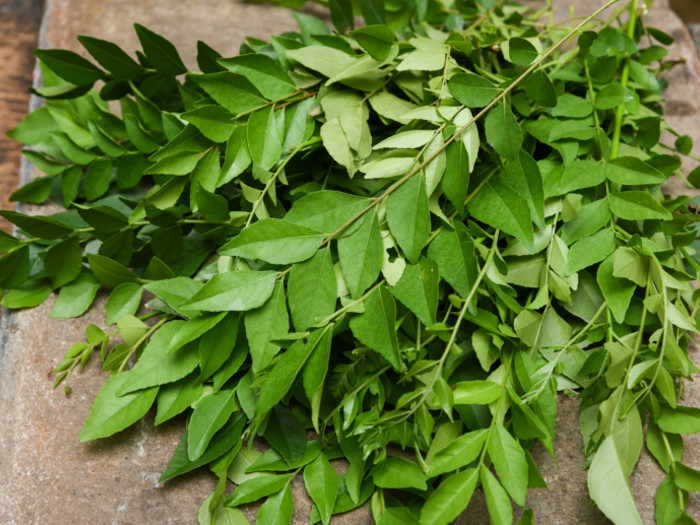Curry leaves are natural flavoring agents with a number of important health benefits. They not only give your food a pleasant aroma but can enhance its flavor and health benefits.
The health benefits of curry leaves also include weight loss, treating various gastrointestinal issues like diarrhea, managing diabetes, improving eyesight, and relieving stress. Curry leaves contain various antioxidant properties that help maintain optimum cholesterol balance. They are also believed to have cancer-fighting properties.
What are Curry Leaves?
Curry leaves, or kadi patta, are aromatic herbs used for medicinal and culinary purposes. The curry tree is scientifically known as Murraya koenigii Spreng and it belongs to the Rutaceae family. It is native to India and is usually found in tropical and subtropical regions. It is cultivated in various other countries including China, Australia, Nigeria, and Ceylon.
In Ayurvedic medicine, curry leaves are believed to have several medicinal properties: anti-diabetic, antioxidant, antimicrobial, anti-inflammatory, anti-carcinogenic, and hepatoprotective. Moreover, the roots have been used for treating body aches and the bark is used for snake bite relief. Curry leaves resemble ‘neem’ or Indian lilac and their name in most Indian languages translates to ‘sweet neem’.
Curry Leaves Nutrition
The main nutrients found in curry leaves are carbohydrate, fiber, calcium, phosphorus, iron, magnesium, copper, and other minerals. They also contain various vitamins such as B3 (nicotinic acid), vitamin C, vitamin A, vitamin B, vitamin E, antioxidants, plant sterols, amino acids, glycosides, and flavonoids.
They also have a trace, nonsignificant amount of fat (0.1 g per 100 g).
Another chemical constituent present in curry leaves is carbazole alkaloids. A research study published in the Journal of Agricultural and Food Chemistry showed that alkaloids found in the leaves possess antioxidant properties. [1]
Carbazole alkaloids include mahanimbine, murrayanol, mahanineoenimbine, O-methylmurrayamine A, O-methylmahanine, isomahanine, bismahanine and bispyrayafoline. A further study conducted at the Department of Horticulture at Michigan State University suggested that these chemicals have insecticidal and antimicrobial properties as well, specifically mosquitocidal properties. [2]

Stir-fry curry leaves and add them to your salads for a unique flavor. Photo Credit: Shutterstock
Benefits of Curry Leaves
Most people think that curry leaves are only added for flavor and throw the leaves away while eating their soup. However, they are far more important than many realize, and offer a number of health benefits without any side effects.
Weight Loss
A 2010 study has shown that curry leaves extract significantly reduced body weight gain. The presence of carbazole alkaloids in these herbs is the reason behind this effect. [3]
Alleviate Diarrhea
Research shows that the carbazole alkaloids present in curry leaves have antidiarrheal properties. You can consume them by grinding up a couple of curry leaves and making a juice. [4]
Treat Indigestion
According to Ayurveda, curry leaves can be used as a cure for gastrointestinal issues as they are considered to possess mild laxative properties. You can make juice out of these leaves, add lime juice, and consume the mixture to alleviate indigestion. A paste made from the leaves can also be added to buttermilk and taken every morning on an empty stomach to serve the same function. [5]
Fight Infection
Research on curry leaves has revealed that they are effective in fighting bacterial and fungal infections due to the presence of carbazole alkaloids. This compound is known to have antibacterial, anti-inflammatory, and anti-cancer properties. The leaf extracts from the plant have been comparable to popular mainstream antibiotic drugs. [6]
Anti-diabetic Properties
One of the biggest health benefits of curry leaves is diabetes control.
A research study published in the Die Pharmazie – An International Journal of Pharmaceutical Sciences showed that the anti-hyperglycemic properties of the leaves were beneficial in controlling blood glucose levels in diabetic rats. It further notes that curry leaf extract might even be more effective than glibenclamide, an oral hypoglycemic drug. [7]
Fight Oxidative Stress
A research study published in the journal Food Chemistry has indicated that curry leaves are a good source of antioxidants. The presence of various vitamins like vitamin A, B, C, and E help in reducing oxidative stress and free radical scavenging activity. [8]
Heal Wounds
Curry leaves are also helpful in skin care. The juice or paste of the leaves can be applied to burns, cuts, bruises, skin irritations, and insect bites for an expedient recovery and clean healing. [9]
Fight Cancer
The chemical constituents found in curry leaves such as phenols are helpful in fighting cancers such as leukemia, prostate cancer, and colorectal cancers. One research study showed evidence of colon cancer-fighting properties in the carbazole alkaloids extracts from curry leaves. [10] [11]
Lower Cholesterol Levels
These leaves have been shown to have positive effects on reducing LDL or bad cholesterol levels. Studies have shown that they have the potential to reduce LDL cholesterol levels, but further research is needed to confirm the results. [12]
Hair Care
Curry leaves are believed to help in strengthening hair roots. Dry curry leaf powder mixed with oil can be applied to your hair. The paste from curry leaf can also be topically applied to slow the graying process.
Protect the Liver
Your liver plays a major role in the digestive process. Curry leaves can help offer a boost of protection from any attack by free radicals, as well as from viral and bacterial attacks that can result in infection. Research on these leaves has indicated that the tannins and carbazole alkaloids present in the leaves exhibited good hepatoprotective properties. [13]
FAQs
Where to buy curry leaves?
Major chains like Walmart and Target have curry leaves in various forms, meaning that you can even grow your own at home! Smaller natural medicine and Ayurveda-oriented stores will also have these leaves for sale. Again, they have a wide variety of uses, so there are plenty of places to find them.
How to store curry leaves?
You should remove the curry leaves from the stems, wash them, and pat them dry. Place them on a large plate with a sieve or mesh cover and set the leaves out in the sun for 2-3 days. Store the dry leaves in a plastic container; you can even keep them in the fridge and simply get one whenever you need it!
How to use curry leaves for hair?
Curry leaves are very popular in hair care, primarily because they contain antioxidants and amino acids. You can take a handful of these leaves and then mix them with yogurt, smashing them up into a paste. Apply this directly to your hair and leave the mixture in for half an hour. Then, wash the mixture out and clean your hair as usual. This can help rejuvenate hair follicles.
How to make curry leaves oil?
You should start with a pan of coconut oil that you heat up before dropping in the curry leaves. Allow this mixture to simmer for 10-15 minutes, and then let the oil cool down. At that point, you can strain the oil and then use the remaining curry leaf oil whenever you want to massage your scalp or prevent premature graying.
How to make curry leaf powder?
To make curry leaf powder, all you need is a pan, curry leaves, and a pinch of salt. Heat the dried leaves in the pan until they begin to brown, and curl and crisp. Don’t burn the leaves. Add the salt gradually, then put the leaves in a food processor or blender. The leaves will powder very quickly into a fine green spice that you can add to dishes. It’s both delicious and easy to prepare!
How to use curry leaves?
You can use curry leaves in a number of different ways, either in the preparation of food or for certain health benefits that this unique plant offers. You can make curry leaf powder and add it to food to reap the benefits from the antioxidant content of the leaves. You can also grind fresh leaves into a paste and apply it to the skin to prevent infections.
How to grow curry leaves?
Curry trees are hardy plants and can be grown in home gardens relatively easily in warm climates. Many people choose to cultivate their own plants for their seasoning needs. Although curry plants are frost tender, they can be grown indoors, particularly if you live in a cold region, and can flourish from cuttings or seeds!
